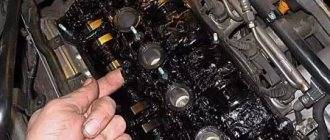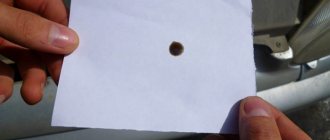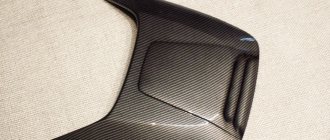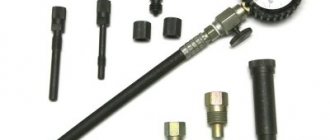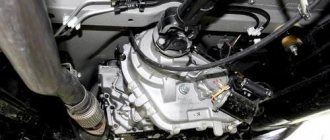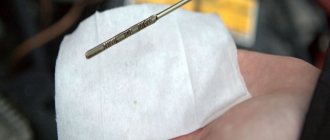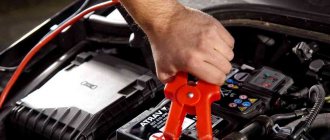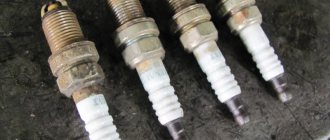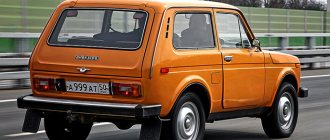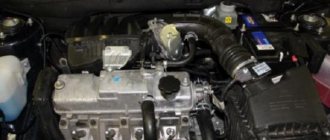Running in the engine after repair
How to properly break in an engine after overhaul? Break-in is necessary after any intervention in the engine. If the intervention was:
1. minimal (for example, replacing a chain or camshaft), running-in can be a minimum of 500 km.
2. With normal, high-quality capital, the running-in period is 1500-2000 km.
3. the block was relined and the piston rings were replaced, but the pistons themselves remained old - with such a repair, the running-in should be much more (perhaps 3-4 thousand) and in the most gentle mode, i.e. never faster than 50-60 km/h, only a very smooth start and no force of the engine at too low or high speeds, i.e. Set yourself a range of 1800-2500 and stay within it. The problem in this case lies in the fact that new, unworn rings are placed in broken piston grooves. If the pistons have lived a hard life and the grooves are badly broken (the breaking of the groove can be assessed by the old ring - if its lower supporting surface is glossy, slightly play with waviness in reflected light and when you run your finger along it from the conditional center to the outer diameter, a step of wear will be felt, then In this situation, the pistons definitely need to be replaced), there is a chance of breaking the rings even when starting the engine. The fact is that the groove in the piston is broken in such a way that its lower plane seems to tilt down. The old ring also wore out along the supporting surface with the same slope, but the new one will begin to twist and has a chance of breaking either immediately or after accumulating a certain amount of fatigue. In general, for pistons, the wear criterion is determined precisely by the breaking of the groove of the upper compression ring; everything else practically does not wear out.
Run-in - 800 km/oil change, 2000 km/oil change. Break-in oil 10W-30, further according to the manual.
Here's another, more correct one:
It is necessary to break in the engine in two cases: when the car has just left the assembly line or after a major overhaul. Run-in is carried out so that all parts and systems of the car “get used to”, thereby increasing the service life of the engine.
In case of incorrect break-in, not very pleasant surprises await you, for example: oil in the air cleaner, high fuel consumption, problems with starting the engine, and so on. Therefore, at first, after buying a new car or major repairs, you will have to follow several boring but necessary rules.
The first and most important rule is not to load the engine, that is: do not drive at high speeds, do not load the car with a large number of passengers and cargo, do not suddenly slow down, drive less in low gears. The first rule applies until the car has traveled about 1,500 kilometers. The second rule is watch your speed. Until the car has covered its first two hundred to three hundred kilometers, the maximum speed should not exceed 80 km per hour. You should (as far as possible) drive at a constant speed, no acceleration, and try not to downshift. To do this, you need to choose a route with minimal congestion and, preferably, without sharp turns. It is best to go for a run-in late in the evening, when there are few cars on the roads, this will allow you to fulfill the second rule.
After the car has traveled over three hundred kilometers, you can gradually increase the speed, within reasonable limits, of course. But still try to drive at a constant speed.
The third rule is don’t skimp on the butter. It is advisable to change the oil at least four times during the entire break-in period. The first replacement must be made when the car has traveled at least five hundred kilometers. Then after 1000 kilometers and at this time the engine should be flushed. The next replacement is after 1500 kilometers, and the last one after 2000 km. Use only natural, high quality oils recommended by the car manufacturer.
After the break-in is completed, change the oil again and flush the engine. Now you can fill in synthetic oil, this will no longer harm the engine. The next replacement can be made after 5000 - 6000 km. A machine accustomed to gentle operation should not be heavily loaded immediately. Any machine is susceptible to sudden overloads, so take care of its “health”, this will save your nerves, money and time. A properly run-in car is less likely to end up in a service center with breakdowns, saves fuel, and picks up speed faster.
Types of running-in
There are usually two types of running-in. They need to be distinguished. After all, correct use of this procedure can increase the resource by up to 20%. This is a very good indicator that will allow you to save on further engine maintenance.
Typically, break-in is understood as a procedure that is performed after a major overhaul of the engine. As a rule, in this case, all the main components are completely replaced, usually only the block and its head are left. In this case, you get an almost new motor. But in order for the parts to get used to each other, a thorough running-in is required. Large services use special stands for the initial procedure. This is impossible in a garage, so you just need to carefully monitor the operating mode of the engine while traveling.
Another point is a partial overhaul of the engine.
. This includes the break-in we analyze after changing the piston rings. Here you need to monitor the process a little less, but there are some nuances that simply need to be taken into account. Also, usually in this case, the mileage for grinding in is shorter, which speeds up the process. Below we will consider in more detail all the listed varieties, so you are guaranteed to avoid mistakes after repair.
Master class: running in after repair
Many owners of their “iron horses” are faced with such a problem as engine “fatigue” and its further overhaul. Change the engine to another? No. Not a good idea. You can install the same “tired” one. Therefore, it is better to qualitatively sort out the old one. But there is one “but”...
One of the most important procedures affecting the service life of a vehicle is running in the engine after any repair work related to the replacement of worn parts with new ones. Moreover, this process must be treated no less responsibly than the repair work itself. Run-in is especially important for those engine components whose operation is associated with friction of its parts against each other, and the efficiency depends on the tightness of their fit.
As a rule, the duration of engine break-in is measured by the vehicle's mileage, the length of which directly depends on the nature of the engine repair:
— with minimal intervention (replacing the camshaft, chain, valves, etc.) 500 km is enough for break-in;
— after a high-quality overhaul, in which almost the parts of all the main components are replaced with new ones — 1500-2000 km;
- after a medium repair, when parts in the main components are partially replaced, a longer run is needed for running-in - up to 2500 kilometers.
For example, if the compression and oil scraper rings were replaced, but the pistons and liners remained old. This is due to the fact that new, unworn rings take much more time to “get used” to the old liners and piston grooves on their working surface than to the almost ideal surface of new parts. Therefore, running in the engine after replacing the rings is a mandatory event, which must be carried out in compliance with all the rules that exist for this process.
The main purpose of running in is to smooth out micro-irregularities by rubbing parts against each other to achieve a tight fit. Increased friction during “grinding in” causes increased heating of engine elements. Therefore, during this period, the power unit should operate in a gentle mode, with minimal loads. Below are the basic rules that must be followed during break-in after installing new piston rings on any type of engine.
An important role, which greatly influences the quality of running-in of a repaired engine, is played by its first start.
To carry out the first start of the engine, the battery must be fully charged, otherwise it may not cope with the first start.
For break-in, use only those brands of engine oil recommended by the manufacturer of your car.
In the absence of an electric fuel pump, fuel is pumped manually.
Start the engine and look at the oil pressure warning light located on the instrument panel. If the light does not go out after five seconds, turn off the engine and find out the reason for the low oil pressure. Under no circumstances try to increase the pressure by frequently pressing the accelerator pedal - running the engine in the absence of oil in its components can lead to rapid and irreversible damage to the surface of the rubbing parts.
If after starting the warning light goes out, then everything is fine with the oil pressure.
Warm up the power unit at idle to a temperature of 80-90°C. At the same time, be sure to ensure that there are no leaks of technical fluids. When the engine warms up, turn it off and wait until it cools down to 40-50°C. Then start the engine again and warm it up to 80-90°C again. This procedure must be carried out at least 10 times. Then you can move on to running at higher speeds and hit the road.
Rules for running the engine after replacing rings in road conditions:
- The vehicle should not be fully loaded.
- The speed of movement for the first 1000 km should not exceed 80 km/h, from 1000 to 2000 no more than 90 km/h.
- Shift gears in a timely manner.
- Avoid long climbs.
- Avoid sudden accelerations and prolonged periods of sitting in traffic jams.
- Constantly monitor the oil level.
- It is imperative to change the oil and filter after a run of 1000 km, because wear products appear as a result of the “grinding in” of parts.
- Upon completion of the break-in, it is also necessary to change the oil and filter. In addition, all accessible threaded connections are pulled (block head, oil pan, front cover, starter, generator). If necessary, valves, idle speed, belt tension or timing chain are adjusted.
Compliance with all these simple rules will allow you to properly run-in the engine after replacing the piston rings and ensure reliable operation of the car for a long time.
How to do it correctly?
Before starting the process, you need to carry out a number of actions that are mandatory for any type of work. They are standard and apply in any case. At the very beginning, the following procedures are done:
- Be sure to fully charge the battery;
- Before leaving, you need to carry out the next cycle. We start the engine, heat it to 80°C, then turn it off. As soon as it cools down to 40°C, warm it up again. In total you will need to do 7-10 cycles. During which thermal expansion of parts will occur, as well as their initial preparation;
- After all the above steps, be sure to inspect the engine for leaks of oil, antifreeze and other technical fluids. If we find such a phenomenon, we will definitely eliminate it;
- Regardless of the reason for which the procedure is performed, movement with height differences should be avoided;
- At the last stages of lapping, strictly follow the manufacturer’s recommendations regarding optimal engine operation during travel.
These rules apply to all types of engine running-in, regardless of what you did in the car.
The next 700-800 kilometers
You can drive in the same mode, but not at once. That is, you can freely use the car for business trips, but just do not load it. The last 500 kilometers adhere to the manufacturer's recommended operating mode, but at the same time avoid stressing the engine. After this, the oil and filter must be changed. Then you can safely operate the car in your usual mode.
First launch after major overhaul
The first start of the internal combustion engine is carried out according to the following scheme:
- Fill in engine oil. It will take 10 minutes for the lubricant to fill the system. The oil filter is left dry to avoid air lock.
- Connect the fuel pump or supply fuel manually.
- Open the throttle manually if there is no automatic drive.
- Start the starter.
- Spin the motor up to 2000 rpm.
- Leave to idle for 15 minutes until engine rotation becomes stable at operating temperature.
- Turn off the unit and wait for it to cool completely.
Similar article Markers for setting the ignition on the 405 ZMZ timing engine
During startup, the pressure in the lubrication system is monitored. The indicator signal for 4 s indicates incorrect engine assembly. We urgently need to turn off the engine! If the pressure quickly stabilizes, the internal combustion engine is warmed up to operating temperature.
There should be no leaks upon visual inspection. In the first 3 minutes, the engine may knock: the hydraulic compensators are being pumped or the cups are running in. In the future, the sound should become uniform, without vibration. The appearance of a burning smell and slight smoke for the first start is normal - the assembly lubricants are burning through.
If the internal combustion engine is operating stably, start running-in. In order to properly run in the engine after a major overhaul, you need to understand the nuances of the test.
Replacement cost
The price for replacing oil scraper rings and caps ranges from 9,000 to 30,000 rubles. Its growth may be affected by the degree of wear of parts. This adds to the estimated standard hours for the mechanic.
The cost of the parts themselves varies from 5,000 to 20,000 rubles. A complete list of replacements is compiled after disassembling the engine.
The replacement process is not too labor-intensive; rather, it requires accuracy, as well as the necessary knowledge of the car's structure. Under other circumstances, you can entrust this work to professional craftsmen.
Step-by-step instructions for replacing rings and valve stem seals
The decarbonization process removes small deposits. In case of severe wear, a complete replacement of all piston rings and valve stem seals is required:
- The necessary parts are selected in accordance with the make of the machine. You should give preference to original spare parts so as not to bother again later.
- The spark plugs are unscrewed, the cover is removed, and then the entire cylinder head (cylinder head). The oil is drained and the oil pan is unscrewed. Next, the connecting rod caps are unscrewed and the pistons are pulled out.
- Use a puller or a screwdriver to remove the old rings. Using old pistons, the landing grooves are cleaned. It is done carefully with an unnecessary ring. Their installation should be carried out only after connecting the piston to the connecting rod.
- Of all the piston rings, the oil scraper rings are installed first. All operations must be done by hand. On box-shaped ones with a spiral spring, the expander lock rotates 180° relative to the ring lock. For composite ones, the spring is installed first, then the lower plate and the upper one. The plate locks rotate 180° relative to each other.
- After installing the remaining rings, it is necessary to evaluate the appearance of the cylinders. In case of severe wear, boring and honing are performed.
- Place the pistons in their places, screw on the connecting rod caps and the oil pan.
Valve seals also play an important role in retaining oil. They remove excess from the valves. The caps are replaced either with or without removing the cylinder head.
- In the first case, the crankshaft is turned with a wrench until the first pair of pistons is set to the top dead center (TDC) position. This is done to keep the valve from falling into the cylinder.
- The axles of the intake and exhaust rocker arms with hydraulic compensators are removed. In many models they can fall out - nylon clamps are useful for this.
- Using a special puller, you must simultaneously compress the valve springs and remove the crackers with tweezers. They are needed to compress the spring relative to the valve axis. An assistant will come in handy here.
- After removing the worn cap, install a new one in its place. It should be remembered that they are divided into inlet and outlet.
- The crackers are installed in reverse order. Next, you should rotate the crankshaft to the TDC position of the other pair of pistons. Everything is done the same way. If you replace the caps and remove the cylinder head, you can pull out the valves and assess their condition. The resulting carbon deposits must be cleaned off.
- After installing the valves and springs in place, reinstall the rocker arm axles.
- Along the way, you can check the tension of the timing belt, and also use the marks to establish the correct ignition. This will protect the CPG from wear.
- Install the cylinder head cover. It will require a new gasket.
- Install a new filter and fill with oil.
- Connect all devices, start the engine.
We recommend:
How to wash a car engine with your own hands correctly?
Starting operation of the unit with new parts will require their grinding in. Unnatural sounds and whistles are possible. Smoke may pour out of the exhaust pipe, and the engine may stall. For the first 500 - 1000 km, you should not increase the speed much.
